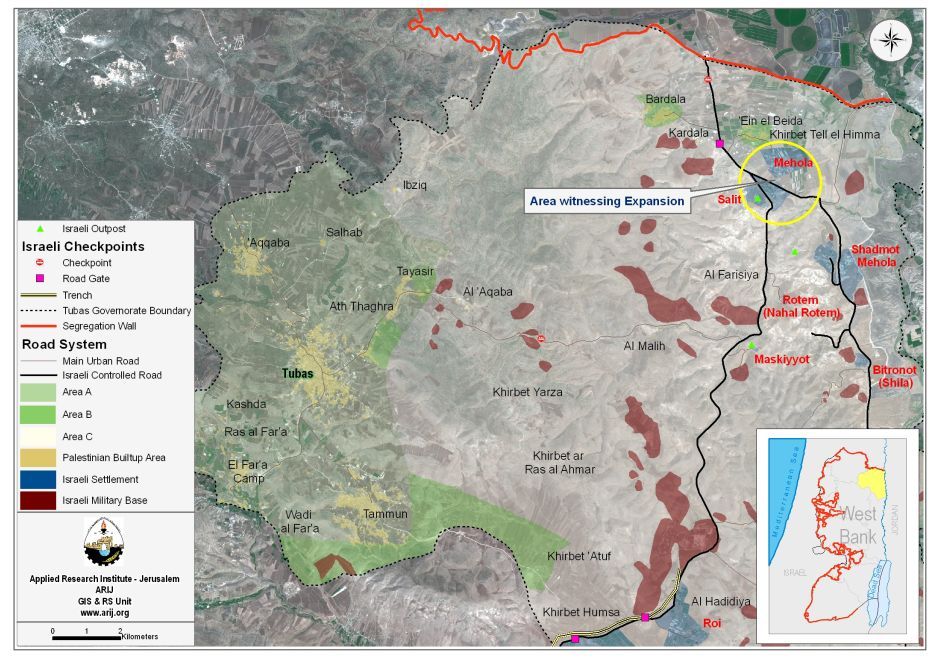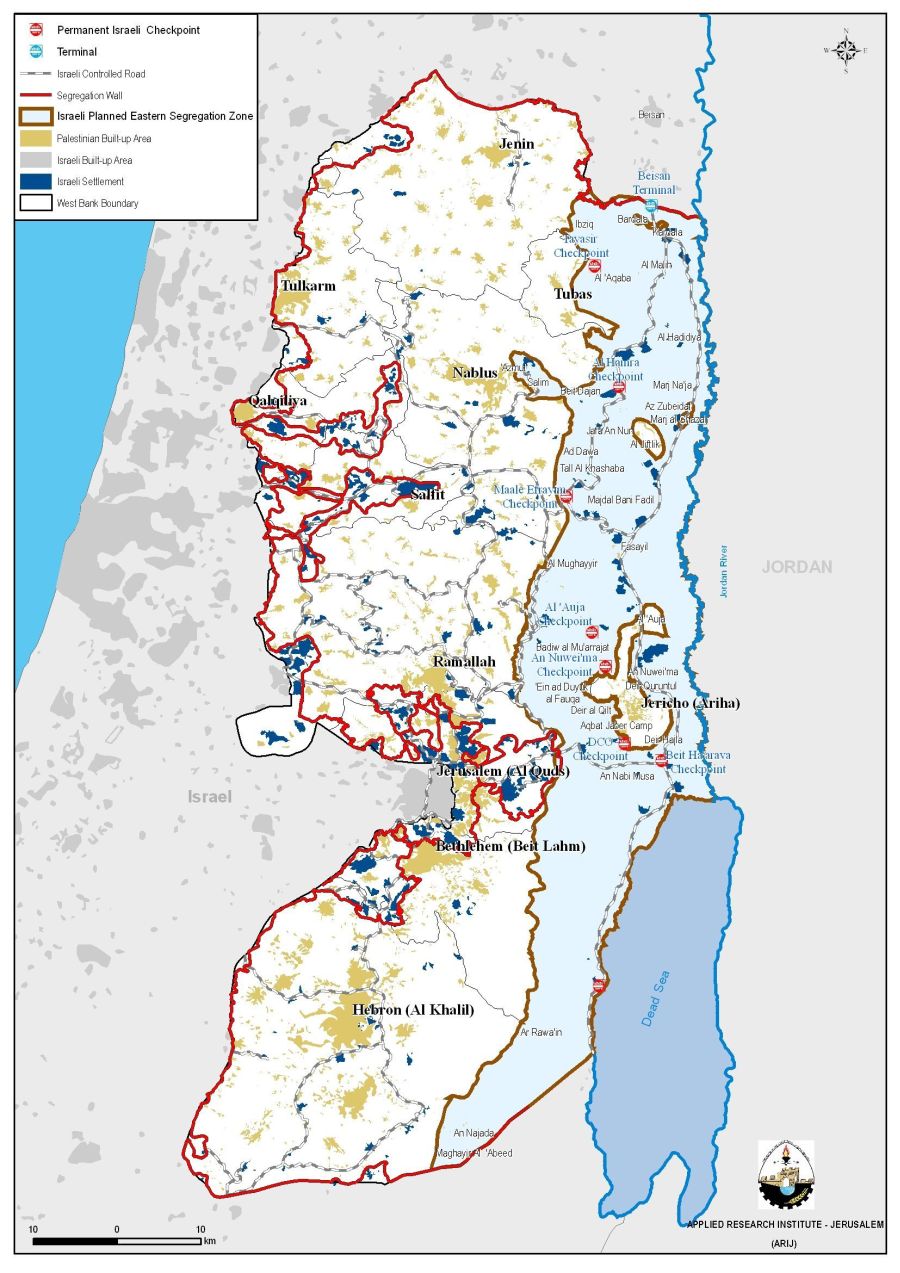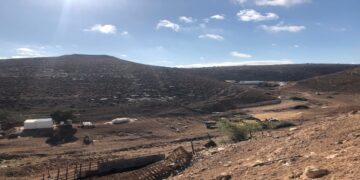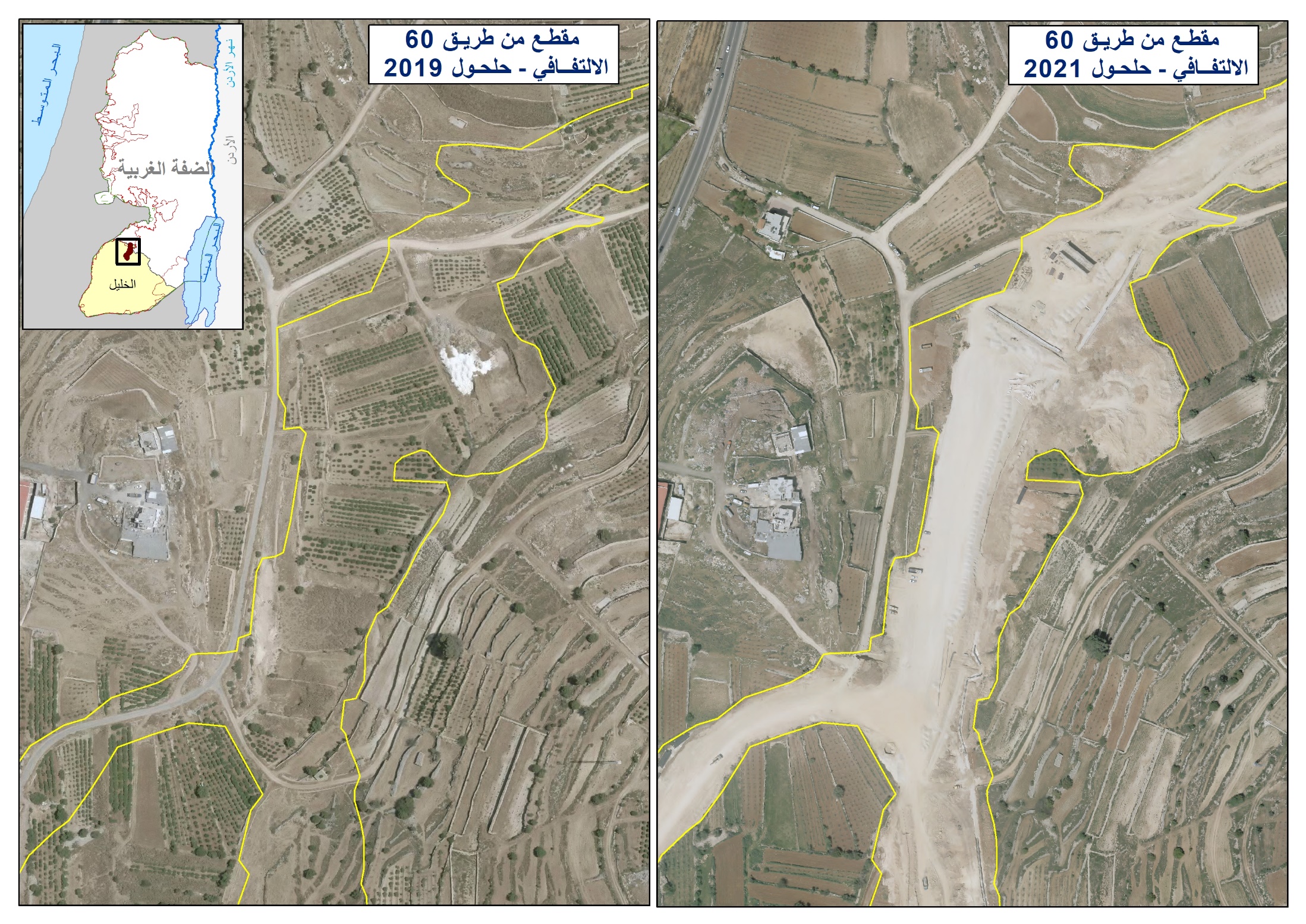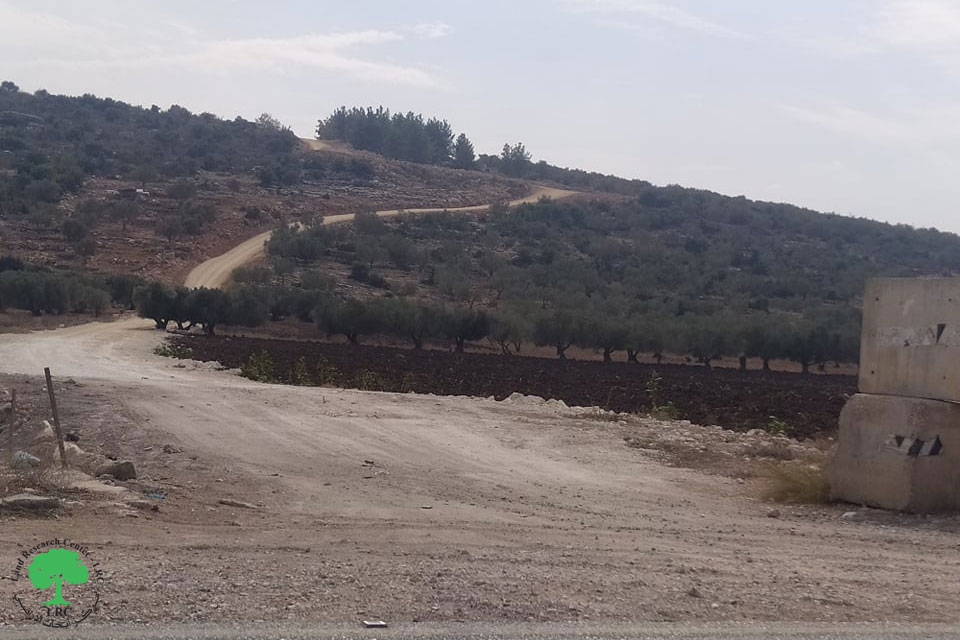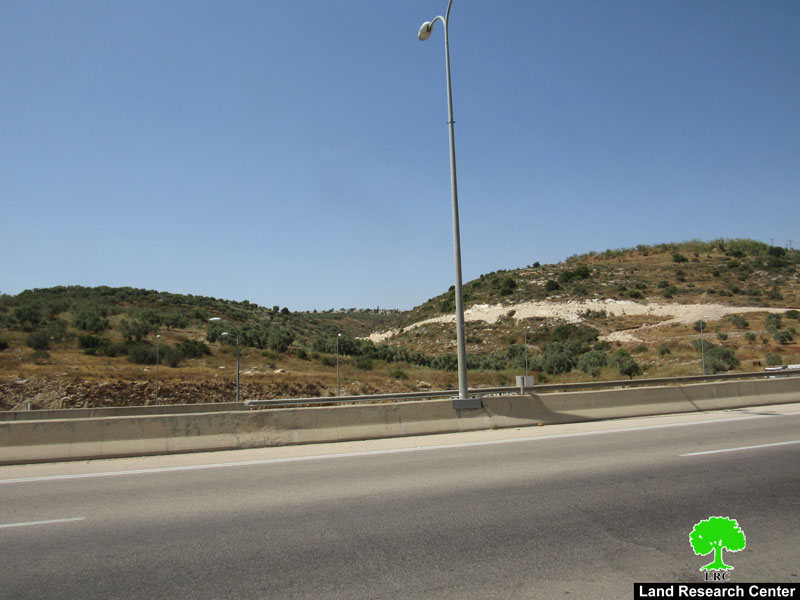on September 15th, 2006, the Israeli occupation forces started constructing a new colonial road in the northern valleys, on lands of Bardala, Kardala and 'Ein Al Bayda in Tubas Governorate at the north eastern part of the West Bank. The new road will connect the settlement of Mehola with its neighboring settlement Giv'at Sal'it.
The Israeli settlement of Giv'at Sal'it started out as an outpost five years ago (in 2001) when a number of Israeli settlers families from Mehola settlement decided to establish a community of their own in an area close to the Settlement itself; This outpost, throughout the years, was provided with all basic services: electricity, water networks etc. which contributed much to its transformation from diminutive outpost to a gathered settlement that includes many Israeli settlers.
The Building of Israeli settlements is usually accompanied by the construction of a series of bypass roads (Colonial Roads) for the use of Israeli settlers to link settlements in the West Bank together and with Israel. The term bypass road was born with Oslo agreements to designate roads in the Palestinian territory that link Israeli settlements to military camps and/ or to Israel. These bypass roads are strictly restricted to the use of Israeli settlers only. In Tubas Governorate, two bypass roads exist (Bypass road # 90 & bypass road #578) and both extend a total length of 44.6 km.
-
Bypass road # 90: East of Tubas Governorate and parallel to the Jordan River. It commences from the upper Jordan Valley and runs southward to bypass the lands of Kardala, Bardala villages towards the settlements of Mehola and Giv'at Salit (was first constructed as an outpost) and then continues to reach the settlements of Shadmot Mehola and shilla, after that the bypass road continues towards the south connecting a considerable number of Israeli Military bases established south of Tubas Governorate.
-
Bypass road # 578: Emerges from Bypass Road number 90, from Giv'at Salit settlement and extends towards the south connecting the settlements of Rotem and Masskiyot and a number of Israeli military bases in the area to finally reach the settlements of Roi' and Baqa'ot south of Tubas Governorate.
The Israeli settlement Program in Tubas Governorate Following the 1967 War
Mehola and Sal'it settlements are only two among many other Israeli settlements already exist in Tubas Governorate and occupy much of its area. This settlement program commenced soon after the Israeli Army captured the West Bank during the 1967 war, after which, the settlement program developed throughout the years of Israeli occupation and with the direct consentient of the consecutive Israeli Governments. Today, 9 Israeli settlements exist on the lands of Tubas Governorate, in addition to 3 Israeli outposts of which Giv'at Sal'it is one. Table 1 and table 2 below list the Israeli settlements and outposts built on Tubas lands.
Table 1: List of Israeli Settlement constructed on lands of Tubas Governorate
|
|
Israeli Settlement |
Date of Establishment |
Pop 2004 |
Area in Km (2005) |
|
1 |
Mehola |
1968 |
360 |
1.759 |
|
2 |
Beqaot |
1972 |
152 |
2.353 |
|
3 |
Pelas (Ballas), |
1975 |
0 |
0.323 |
|
4 |
Roi |
1976 |
115 |
1.573 |
|
5 |
Shadmot Mehola |
1978 |
517 |
1.259 |
|
6 |
Hemdat |
1980 |
120 |
0.255 |
|
7 |
Bitronot (Shila) |
1984 |
0 |
0.128 |
|
8 |
Rotem (Nahal Rotem) |
1984 |
0 |
0.04 |
|
9 |
Maskiyyot |
1987 |
507 |
0.018 |
|
|
Total |
|
1771 |
7.708 |
Source: ARIJ -GIS Database 2006
Table 2: List of Israeli outposts constructed on lands of Tubas Governorate
|
Table 2: Israeli Outposts in Tubas Governorate |
|
|||
|
Closest Mother Settlement |
No. of Structures |
Outpost Name |
Period |
Status |
|
Mehola |
13 |
Giv'at Sal'it |
Feb 2001 – Nov 2002 |
Inside Colony Border 2002 |
|
Maskiyyot |
1 |
North Maskiyyot |
Feb 2001 – Nov 2002 |
Outpost |
|
Shadmot Mehola |
1 |
North West Shadmot Mehola |
Feb 2001 – Nov 2002 |
Outpost |
|
Total |
15 |
|
|
|
Source: ARIJ -GIS Database 2006
Moreover, a total of 60 Israeli military bases occupying an area of 16.2 km² of the lands in Tubas Governorate have been established to service and protect the Israeli Settlements in the area. See Map 1
Israel Isolates the Jordan Valley
The Israeli Occupation forces managed throughout the years of occupation to isolate the eastern part of Tubas Governorate, which constitutes the greater part of the governorate area, all of which part of the overall Israeli plan to control and separate the Jordan Valley from the rest of the West Bank Governorates. Unlike, the Segregation Wall Israeli is building along the western terrains of the West Bank, Israel has resorted to a different kind of control method to tighten its grip on the Jordan Valley area through establishing some 25-30 checkpoints across the 200 Km Jordan Valley extent, which severely affected the daily lives of tens of thousands of Palestinians accessing these checkpoints. Today, there are 6 checkpoints (of various kinds) control the movement of Palestinians into and out of Tubas Governorate, See table 3 listed below.
Table 3: Israeli Checkpoints in Tubas Governorate
| No. |
Name |
Type |
Location |
| 1 |
Bisan (Hasam Tzahub) Commercial Crossing |
Crossing Border |
Upper Jordan Valley |
| 2 |
Tayasir military base and check point. |
Checkpoint |
Located East of Tubas City and is considered as one of the main arteries that connects the Jordan Valley with Tubas and the northern Governorates. |
| 3 |
Road Gate 1 |
Road Gate |
At Kardala and Kherbit Tel Al Himma Junction |
| 4 |
Road Gate 2 |
At Roi' Junction |
|
| 5 |
Road Gate 3 |
At Baqa'ot Junction |
|
| 6 |
Trench |
Trench |
Extends 4.9 km on lands of Tubas Governorate from the lands of Kherbit Humsa, and moves southward parallel to Bypass # 578 and end at Baqa'ot settlement in the south. |
Source: ARIJ -GIS Database 2006
Bisan Crossing (Hasam Tzahub)
This is one of 18 crossings/ terminals that Israel has constructed or plans yet to construct along the route of the Segregation Wall in the West Bank in addition to 23 secondary crossing points to control Palestinians movement to the isolated lands behind the Segregation Wall in the “seam zone” area and to Israel. Bisan (Hasam Tzahub) is designated as Commercial terminal and is already operating to control the movement of Palestinian goods into and out of the Jordan Valley.
The Israeli checkpoints in and around Tubas Governorate and along the Strip of the Jordan Valley is the tool Israel is using to take control over the area and separate it from the rest of the West Bank. They serve as an alternative to the construction of a Segregation Wall along the Eastern Part of the West Bank to create another 'Seam Zone' very identical to that located between the route of the Segregation Wall and the 1949 Armistice Line (Green Line) as indicated by the late Israeli Prime Minister Ariel Sharon on April 2004 that 'the eastern barrier will be maintained by blocking access to the Jordan Valley region,' he added that 'a wall is not likely to be erected in the near future, unless there are military necessities.' He also pointed that 'the Jordan valley area will remain under Israeli control even after reaching a settlement with the Palestinians as it is considered to be a strategic security zone.'
The Segregation Wall in Tubas Governorate
Tubas Governorate is located in the Jordan Valley upper northern area and constitutes about 27.6% of its total area (841000 dunums). It is bordered by Nablus Governorate from the south and Jenin Governorate from the north. The Governorate occupies an area of 365983 dunums (6.5% of the total West Bank Area 5661000 dunums) with a total population of about 48127 residents according to the Palestinian Central Bureau of Statistics population projection 2006.
The Segregation Wall in Tubas Governorate extends a length of 14.3 km. It was constructed during the first phase of the Segregation Wall in 2003. It commences from southeastern part of Al Mutalla village in the upper Jordan Valley penetrating deep into the lands of Tubas Governorate (about 1 km) and continues eastwards until it reaches the far upper east of Tubas Governorate. The Wall isolates a total of 1845 dunums of Tubas Governorate land area (365983 dunums), most of which are Agricultural as appear in Table 4 below and map 2
Table 4: Land Use Land Cover of Tubas Governorate and Lands Segregated north of the Wall.
|
Land-Use Land-Cover Type |
Area in Dunums |
Area Segregated north of the Wall (in dunums) |
|
Arable Land (Permanent Crops) |
99287 |
670 |
|
Heterogeneous agriculture |
1860 |
0 |
|
Permanent crops |
70373 |
618 |
|
Plastic Houses |
94 |
0 |
|
Mine, dump & construction sites |
49 |
0 |
|
Israeli Military Base |
15758 |
0 |
|
Jewish Colony |
7385 |
0 |
|
Palestinian Built-up Area |
6249 |
0 |
|
Forest |
2399 |
230 |
|
Open space with little or no vegetation |
30241 |
0 |
|
Shrub & or herbaceous vegetation associations |
12457 |
327 |
|
Pastures |
119831 |
0 |
|
Total Area |
365983 |
1845 |
Source: ARIJ Database 2006
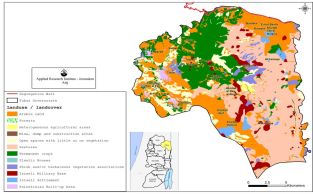
Map 2: Land use/ Land cover and Segregation Wall route in Tubas Governorats
Promoting Israeli colonial activities in the Jordan Valley
The consecutive Israeli Governments have encouraged the colonial activities in the Jordan valley aiming at reinforcing the Jewish existence there. Such encouragements were obvious in the many statements stated by many Israeli officials regarding the issue of the Jordan Valley.
-
Israel's Prime Minister Ariel Sharon said that Israel will not discuss a freeze on Jewish settlement construction with the Palestinians and the occupied Jordan Valley will remain in Israel's hands 'forever.' 2001.
-
The proposal of the Israeli Agricultural Minister, Yisrael Katz, in July 2004 to confiscate 31,000 Dunums of lands in the Jordan Valley to expand the Israeli settlements and increase the settler's population in that area.
-
Sharon statement to Haaretz on April 24, 2005, 'The Jordan Rift Valley is very important and it's not just the rift valley we're talking about [but]…up to the Allon road and a step above the Allon road. In my view, this area is of extreme importance.'
-
The Israeli Defense Minster Shaoul Mofaz said in an interview with Al Jazeera on July 12th, 2005 'We will never give up on [the Jordan Valley], so we can ensure we can continue living here in all changing realities,' The Jerusalem Post, July 11, 2005.
-
The preliminarily approval of late Israeli Prime Minister, Ariel Sharon and the financial committee in June 2005 to invest $50 million over the coming five years to strengthen the settlements in the Jordan Valley.
-
The declaration of the former Israeli Prime Minister, Benjamin Netanyahu, in June 3, 2005 that 'the Jordan Valley would never be included in any Israeli withdrawals. 'The Jordan Valley will stay under Israel's control forever'; it is the eastern defensive shield of Israel'. We will not return to the '67' borders, which were indefensible.' Quoted from: Israeli National news website, June 3, 2005.
-
Al Jazeera website published on June 25, 2005 an article which unveils a plan by the 'the Israeli ministry of agriculture' to double the number of Illegal Israeli settlers living in the Jordan Valley'. According to Benjamin Rom, spokesman of the Israeli ministry of Agriculture 'The plan which has already won approval from within different ministries will increase the number of residents in 21 settlements by 50% in a year and then by a further 50% in the following year,' . Full article.
-
Current Israeli Prime Minister Ehud Olmert have said in an interview prior to his rise to power 'Israel should keep the Jordan Valley, as well as East Jerusalem and major settlement blocks, as part of a final settlement.' BBC News reports. See Map 3
The Israeli Colonial Activities in International law
Israel's colonization of the Occupied Palestinian Territory (OPT) violates numerous United Nations Security Council and General Assembly Resolutions, primarily
-
UN Security Council Resolution 242 (1967), which calls for 'the withdrawal of all Israeli armed forces from territories occupied' in the 1967 war.
-
UNSC 242 effectively outlaws Israel's 39-year occupation of the West Bank (including East Jerusalem) and the Gaza Strip.
The principles of Resolution 242 are reiterated again in Security Council Resolution 452 (1979) which calls upon 'the Government and people of Israel to cease, on an urgent basis, the establishment, construction and planning of settlements in the Arab territories occupied since 1967, including Jerusalem,' the Security Council Resolution 446 (1979) which '[d]etermines that the policy and practices of Israel in establishing settlements in the Palestinian and other Arab territories occupied since 1967 have no legal validity and constitute a serious obstruction to achieving a comprehensive, just and lasting peace in the Middle East' and a further time in Security Council Resolution 465 (1980) .
Israel's settlement policy is also strictly forbidden by the Fourth Geneva Convention. Israel's program of populating the settlements with Jewish citizens violates Article 49 of the Convention. Article 49 states that 'the occupying power shall not deport or transfer parts of its own population into the territories it occupies.'
Prepared by
The Applied Research Institute – Jerusalem
ARIJ



